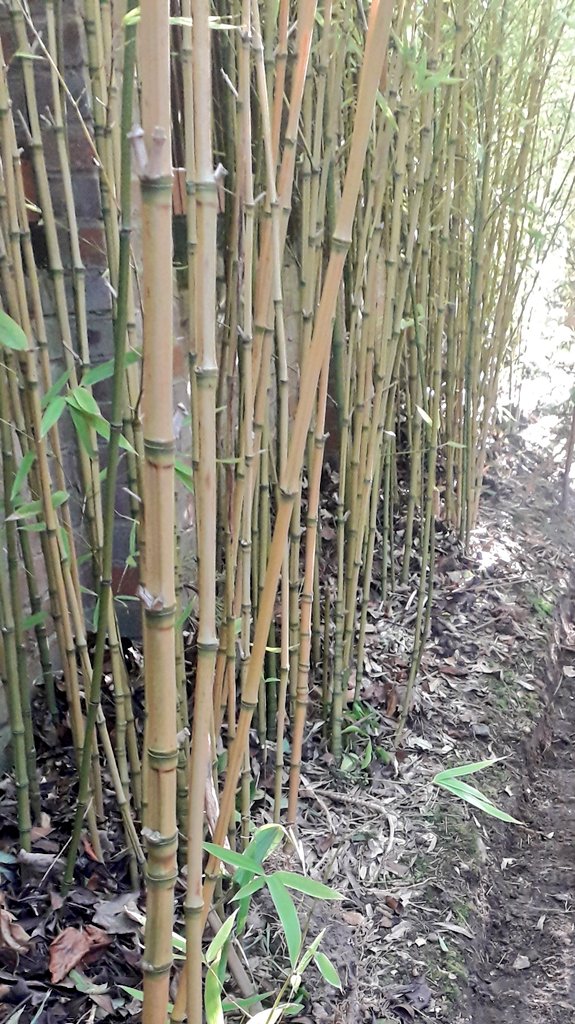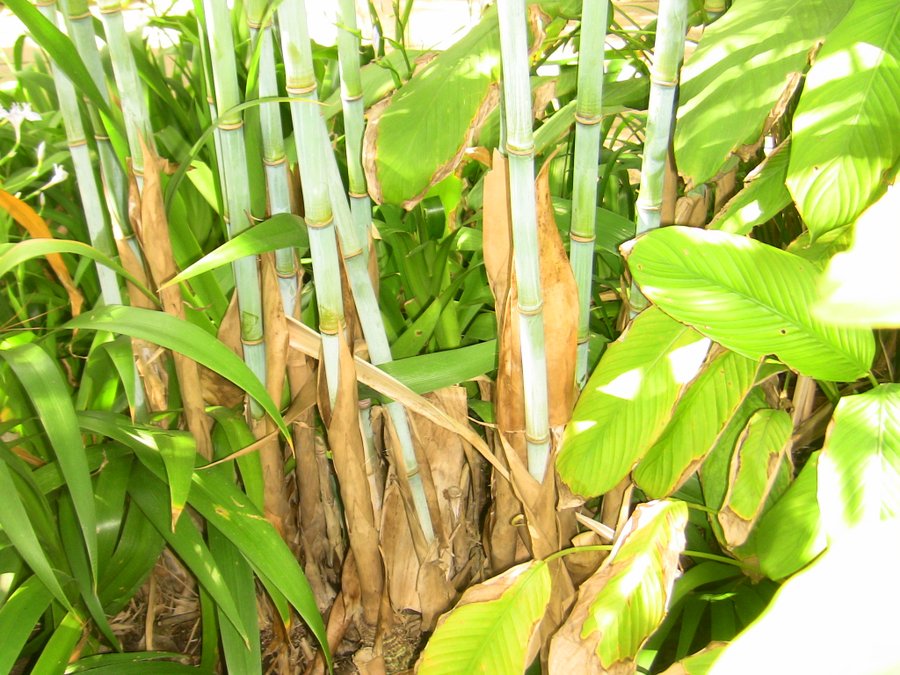Build bamboo boots barrier
Remove bamboo stems, branches and rhizomes
Also, thinning running bamboo means reducing the number of culms and rhizomes by digging them out completely.
Also, thinning running bamboo means reducing the number of culms and rhizomes by digging them out completely.
Do you know there are several varieties of Phyllostachys aurea?
When you buy a phyllostachys aurea bamboo, it can be anyone of these 5 plants.
We created a list of some top UK bamboo sellers online. Check them out on our website.
Care is an important element of growing plants in the garden. Phyllostachys aurea bamboo plant (also known as the Fish-pole Golden Yellow Bamboo) will require care and maintenance as they grow.
We created a list of some top UK bamboo sellers online. Check them out on our website.
If you are wondering where to to buy Phyllosyachys Aurea, check out the list of UK retailers.
You can buy the plants online on at any of these sellers near you.
Phyllostachys aurea.
— G.B.P (@BambooPlantsUK) April 29, 2022
(Also called the Fish Pole #Bamboo for its extensive use as a fishing rod.) pic.twitter.com/3RxG5K98hK
Phyllostachys aurea bamboo plant is one of my favourite bamboos. Its stems are small, tall, bendable and strong. The stems are perfect fishing poles. In the UK, they are ideal garden sticks.
 |
| Phyllostachys aurea |
The stems have been used as fishing poles in China and other parts of Asia and the Pacific regions for centuries. That is why the Phyllostachys aurea bamboo has been called the Fish-pole Golden Bamboo.
The sticks are not too big like the Bamboo Vivax poles or too small like some clumping bamboos seen in the UK. They are just the right bamboo for garden and pots & containers.
We created a list of some top UK bamboo sellers online. Check them out on our website.
Video of fish-pole bamboo in our garden
Here are some ways in which we used the Phyllostachys aurea Fish-pole Golden Bamboo Plant in the garden - visit our YouTube channel for more videos on the uses of bamboo sticks in the garden.
Epipremnum aureum widely known as the Devil's Ivy has many different variations that do well indoors and outdoors. The Devil's Ivy is hard to kill, it tends to adapt extremely well to different light variations from indirect indoor light and part-shade to heavy shade and direct light.
This fast-growing vine will thrive in pots and containers, perfect for both new and savvy plant lovers.
Common name: Pathos Plant, Money Plant, Devil's Ivy
Family name: Epipremnum aureum
Native to: the Pacific Islands (New Guinea & Solomon Islands)
Related plants: Dieffenbachia seguine, Philodendron hederaceum, Arrowhead Plant, Peperomia obtusifolia
Other names include the Devil's vine, golden pothos, Ceylon creeper, hunter's robe, ivy arum, silver vine, Solomon Islands ivy, marble queen, taro vine
Epipremnum Aureum Devil's Ivy Plant is literally the easiest house plant to grow. They grow pretty long. Plant it in well-drained and humid soil and ensure that the soil remains conducive as it grows.
The vine blends into the background, making it one of the easiest plants to grow in small spaces such as windows and bathroom tops.
These lush trailing plants thrive in pots and containers and they are fantastic hanging houseplants.
It grows well in bright indirect light and also tolerates dark areas. It has been found to be great at cleaning the indoor air of dust and stale air, an excellent air purifier.
Devil's Ivy plant can absorb water easily, which makes it ideal for bathrooms and rooms where moisture is high.
Epipremnum Aureum Devil's Ivy Plant is an undemanding low-maintenance plant, but it does not like waterlogged soil. Too much water will result in the roots rotting which can completely kill the plant.
Use a damp cloth clean the top layer of the leaves if you see specks of dust accumulating on them. When cleaning, avoid wiping the underside of the leaves as this can block the vital pores and affect the plant's happiness.
For older plants, you may have to stake them using bamboo sticks or prune the tips to reduce further growth. Also, train the tip back into place for a dense screen cover.
Train the pothos plants up bamboo sticks for a neater look. Get the bamboo sticks here.
This clumping bamboo will thrive in most situations, but preferably in well-drained moist soil. Tolerant of shade and a very reliable clumping bamboo.
In this other article, we provide a detailed guide to Bamboo Care and Maintenance, it gives further details on Before and After Care.
It is one of the best bamboo plants to grow in full shaded sites.
The new shoots and sheaths are covered in variable patterns of purplish-brown tints against the green cluster of leaves and gives Red Zebra bamboo its stunning look.
We are listing 3 bamboos that are similar to the Fargesia murielae ‘Red Zebra ’.
 |
| Clumping blue bamboo dendrocalamus strictus |
We feature prominent UK Home and Garden retailers where you can buy bamboo plants, tools and products.
Here are 3 tips to getting the bamboos off to a good start.
Newly planted Blue Lizard bamboo will require a good amount of water. Also, ensure that the soil remains moist but well-drained until the new plants are rooting.
Here is a Complete Guide to Propagating Bamboo by clump-base division.
Running bamboo plants are resistant to harsh conditions. However, if you see that your running bamboo plants' leaves are turning yellow are dying, you must act fast to save them.
A little care and maintenance will save your plant from dying.
So, how can you care for the dying running bamboos?
The best time for mulching and fertilising is early in Spring before the new bamboo shoots come out, or late in Autumn when you expect cold Winter.
Here are some great places where you can buy the running bamboos for screening and hedging.
The well-established Ivory Ibis bamboo is hardy and can tolerate cold winters. Also, this bamboo can also withstand drought, but it will not survive prolonged dry spells.
Its hardiness and drought resistance make this bamboo an excellent pot plant for roof terraces or apartments and other small outdoor spaces.
Here is a Complete Guide for Propagating Bamboo by clump-base division.
The 6 pointers below put in perspective what you can do to ensure that your clumping bamboo, Fargesia murielae ‘Ivory Ibis’, remains healthy.
It is an ideal choice for a formidable natural hedge or privacy screen.
The similarities are based on 5 important factors: Fargesia bamboo, similar height, similar foliage, and similar hardiness and can be used as a hedging screen.
We also featured a special group of Award-Winning Bamboo Plants.
These quality checks will help you to avoid any disappointments after setting up.
The best thing to do is to ensure that the bamboo screening panels are treated, and panel wires are coated to protect the bamboo rolls.
An updated version of this post is available here (How to use bamboo panels to build fence screening)
Find out about the uses of bamboo sticks
We are a dedicated Bamboo website providing general Guides for Caring for Bamboo Plants and ideas for Using Eco-friendly Bamboo products.
Each link takes you to the page with detailed intructions with pictures to help you build your own or give you an idea about how to make yours.
The cylindrical shape and hollow chamber along the bamboo stems make it easy to create simple DIY storage for homes and gardens.
Bamboo canes (sticks) have been used in gardening hacks and DIY projects. These 10 ideas will help you as you try out these creative ideas.
In this Bamboo Bathroom Storage Hacks, you'll find out how to make a bamboo storage for toothpaste and toothbrish, and bamboo storage tube for storing important documents.
Each link takes you to the page with detailed intructions and pictures to help you build you own or give you an idea about how to make yours.
Take a look at how to make stationery storage and cups from the common bamboo plants.
Apply light varnish or wood paint for a fine finishing touch.
Each link takes you to the page with detailed intructions and pictures to help you build you own or give you an idea about how to make yours.